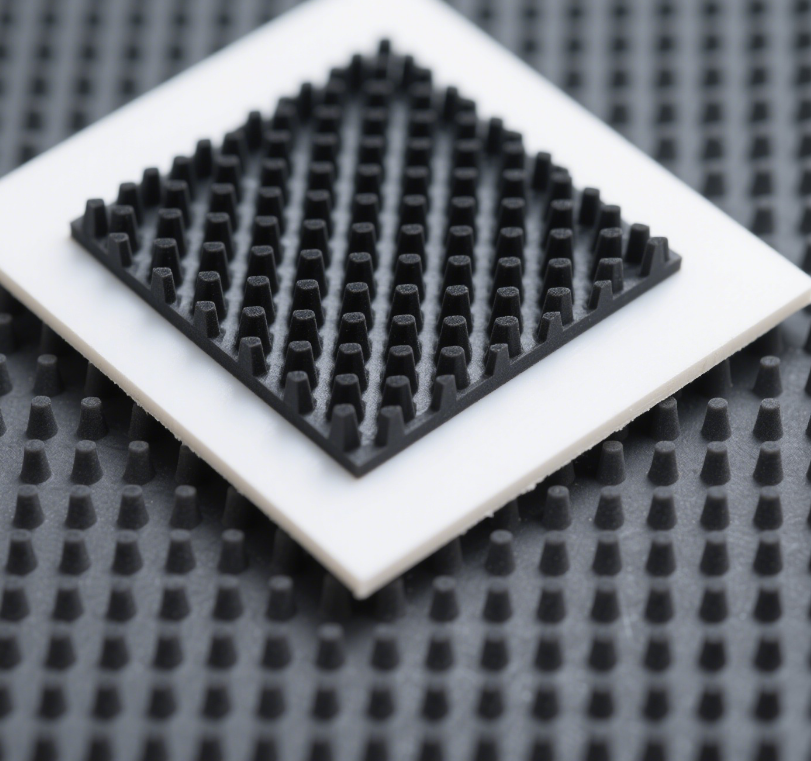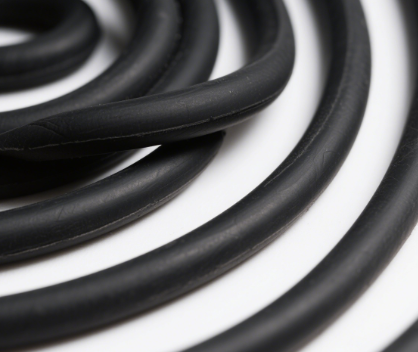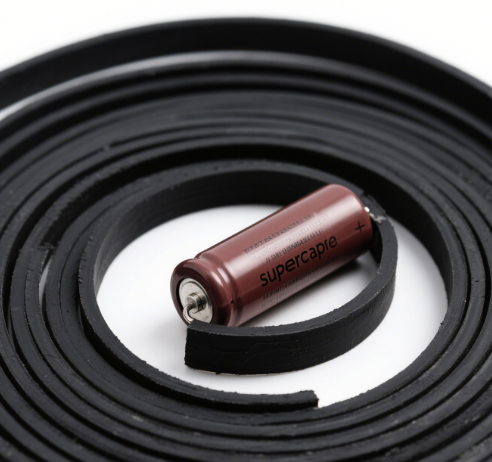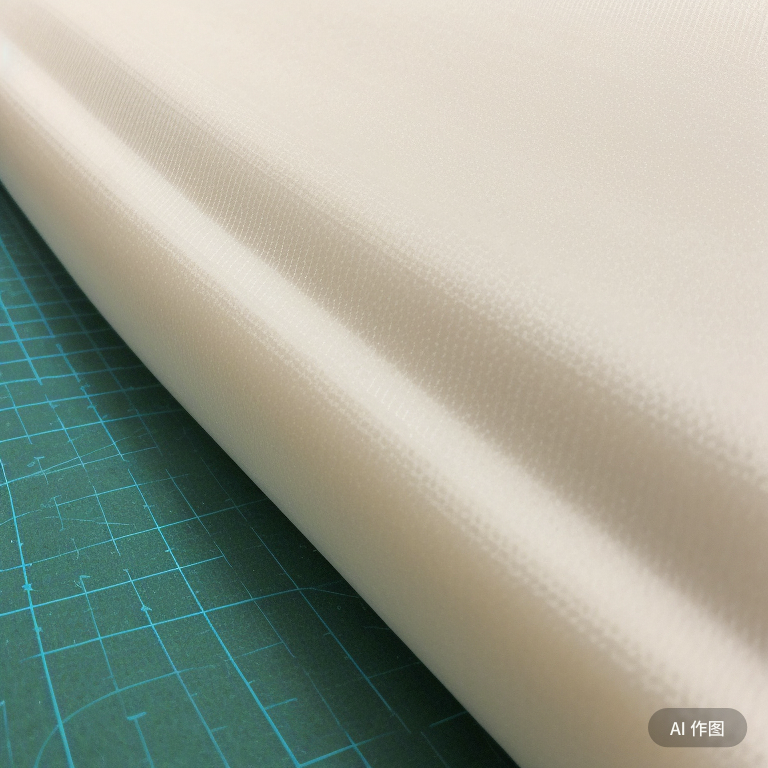Research on the Environmental Resistance Performance of Wave-Absorbing Silicone Rubber
2025/04/18
0
 I. Introduction
I. IntroductionWave-absorbing silicone rubber, with its unique wave-absorbing performance and good processing characteristics, has been widely applied in fields such as electronic communication, aerospace, and national defense and military industries. However, the actual application environment is complex and changeable, including high temperature, low temperature, high humidity, salt spray, ultraviolet radiation, etc. These environmental factors can affect the wave-absorbing performance, mechanical properties, and physical and chemical properties of wave-absorbing silicone rubber, thereby threatening its service reliability and lifespan. Therefore, in-depth research on the environmental resistance performance of wave-absorbing silicone rubber is of great significance for expanding its application range and improving product quality. This study will systematically explore the influence mechanisms of different environmental factors on the performance of wave-absorbing silicone rubber and propose corresponding improvement strategies.
II. Influence of High Temperature Environment on the Performance of Wave-Absorbing Silicone Rubber
(1) Performance Change Manifestations
In a high temperature environment, the movement of the molecular chains of wave-absorbing silicone rubber intensifies, and the cross-linked network structure gradually relaxes. As the temperature rises above 150°C, small molecular additives such as plasticizers in the silicone rubber may volatilize, resulting in an increase in the hardness of the material and a decrease in its flexibility. In terms of wave-absorbing performance, high temperature can change the interfacial bonding state between the wave-absorbing filler and the silicone rubber matrix. The filler may agglomerate or migrate, affecting its uniform dispersion, and thus reducing the wave-absorbing performance. For example, when the temperature reaches 200°C, the reflection loss value of the wave-absorbing silicone rubber filled with carbonyl iron powder in the X-band increases significantly, and the wave-absorbing efficiency decreases by about 30%.
(2) Analysis of the Influence Mechanism
High temperature promotes the oxidative degradation of the molecular chains of silicone rubber, causing the Si-O bonds to break, resulting in shorter molecular chains and a decrease in molecular weight. At the same time, high temperature accelerates the oxidation reaction on the surface of the wave-absorbing filler. For example, carbonyl iron powder is oxidized to iron oxides at high temperatures, and its magnetic properties change, weakening its magnetic loss ability. In addition, high temperature can also cause a mismatch in the thermal expansion coefficients between the silicone rubber and the wave-absorbing filler, generating thermal stress inside the material and damaging the microscopic structure of the material, further affecting its performance.
(3) Improvement Strategies
(1) Performance Change Manifestations
In a high temperature environment, the movement of the molecular chains of wave-absorbing silicone rubber intensifies, and the cross-linked network structure gradually relaxes. As the temperature rises above 150°C, small molecular additives such as plasticizers in the silicone rubber may volatilize, resulting in an increase in the hardness of the material and a decrease in its flexibility. In terms of wave-absorbing performance, high temperature can change the interfacial bonding state between the wave-absorbing filler and the silicone rubber matrix. The filler may agglomerate or migrate, affecting its uniform dispersion, and thus reducing the wave-absorbing performance. For example, when the temperature reaches 200°C, the reflection loss value of the wave-absorbing silicone rubber filled with carbonyl iron powder in the X-band increases significantly, and the wave-absorbing efficiency decreases by about 30%.
(2) Analysis of the Influence Mechanism
High temperature promotes the oxidative degradation of the molecular chains of silicone rubber, causing the Si-O bonds to break, resulting in shorter molecular chains and a decrease in molecular weight. At the same time, high temperature accelerates the oxidation reaction on the surface of the wave-absorbing filler. For example, carbonyl iron powder is oxidized to iron oxides at high temperatures, and its magnetic properties change, weakening its magnetic loss ability. In addition, high temperature can also cause a mismatch in the thermal expansion coefficients between the silicone rubber and the wave-absorbing filler, generating thermal stress inside the material and damaging the microscopic structure of the material, further affecting its performance.
(3) Improvement Strategies
- Select a high-temperature-resistant silicone rubber matrix: Replace ordinary vinyl silicone rubber with phenyl silicone rubber or vinyl phenyl silicone rubber. These special silicone rubbers have higher thermal stability and can be used for a long time above 250°C.
- Add high-temperature-resistant additives: Add an appropriate amount of thermal stabilizers, such as organic tin compounds and rare earth oxides, to inhibit the oxidative degradation of silicone rubber; use high-temperature-resistant plasticizers, such as phenyl silicone oil, to reduce the volatilization of small molecular additives at high temperatures.
- Perform surface treatment on the wave-absorbing filler: Use silica, alumina, etc. to coat the surface of magnetic fillers such as carbonyl iron powder to prevent their oxidation at high temperatures and enhance the interfacial bonding force with the silicone rubber matrix.
III. Influence of Low Temperature Environment on the Performance of Wave-Absorbing Silicone Rubber
(1) Performance Change Manifestations
In a low temperature environment, the mobility of the molecular chains of silicone rubber is greatly restricted, and the material gradually becomes harder and more brittle. When the temperature drops below -40°C, the tensile strength and elongation at break of wave-absorbing silicone rubber decrease significantly, and cracks or even breakage are likely to occur. In terms of wave-absorbing performance, low temperature can cause micro-cracks at the interface between the wave-absorbing filler and the silicone rubber matrix, disrupting the propagation path of electromagnetic waves and deteriorating the wave-absorbing performance. For example, at -50°C, the reflection loss value of the wave-absorbing silicone rubber containing carbon nanotubes in the Ku-band decreases significantly, and the wave-absorbing effect deteriorates.
(2) Analysis of the Influence Mechanism
Low temperature leads to the glass transition of the molecular chain segments of silicone rubber, causing the loss of the flexibility of the molecular chains and a sharp increase in the elastic modulus of the material. At the same time, the difference in the thermal expansion coefficients between the wave-absorbing filler and the silicone rubber matrix is more prominent at low temperatures, resulting in a large stress concentration at the interface, triggering the generation and propagation of micro-cracks. In addition, low temperature may also affect the electromagnetic properties of the wave-absorbing filler. For example, the magnetic permeability of magnetic fillers changes at low temperatures, affecting the magnetic loss mechanism.
(3) Improvement Strategies
(1) Performance Change Manifestations
In a low temperature environment, the mobility of the molecular chains of silicone rubber is greatly restricted, and the material gradually becomes harder and more brittle. When the temperature drops below -40°C, the tensile strength and elongation at break of wave-absorbing silicone rubber decrease significantly, and cracks or even breakage are likely to occur. In terms of wave-absorbing performance, low temperature can cause micro-cracks at the interface between the wave-absorbing filler and the silicone rubber matrix, disrupting the propagation path of electromagnetic waves and deteriorating the wave-absorbing performance. For example, at -50°C, the reflection loss value of the wave-absorbing silicone rubber containing carbon nanotubes in the Ku-band decreases significantly, and the wave-absorbing effect deteriorates.
(2) Analysis of the Influence Mechanism
Low temperature leads to the glass transition of the molecular chain segments of silicone rubber, causing the loss of the flexibility of the molecular chains and a sharp increase in the elastic modulus of the material. At the same time, the difference in the thermal expansion coefficients between the wave-absorbing filler and the silicone rubber matrix is more prominent at low temperatures, resulting in a large stress concentration at the interface, triggering the generation and propagation of micro-cracks. In addition, low temperature may also affect the electromagnetic properties of the wave-absorbing filler. For example, the magnetic permeability of magnetic fillers changes at low temperatures, affecting the magnetic loss mechanism.
(3) Improvement Strategies
- Adjust the molecular structure of silicone rubber: Introduce flexible chain segments, such as polyether chain segments, into the molecular chains of silicone rubber to lower the glass transition temperature of the material and improve its low-temperature flexibility.
- Add low-temperature plasticizers: Use low-molecular-weight polyester plasticizers or diol-based plasticizers. These plasticizers are not easy to crystallize at low temperatures and can effectively reduce the hardness of silicone rubber and improve its low-temperature performance.
- Optimize the interface between the filler and the matrix: Modify the surface of the wave-absorbing filler with a coupling agent to enhance the interfacial bonding force between the filler and the silicone rubber matrix at low temperatures and reduce the generation of micro-cracks.
IV. Influence of High Humidity Environment on the Performance of Wave-Absorbing Silicone Rubber
(1) Performance Change Manifestations
In a high humidity environment, wave-absorbing silicone rubber easily absorbs moisture, resulting in an increase in the dielectric constant and the tangent of the dielectric loss angle of the material. The intrusion of moisture will disrupt the interfacial bonding between the wave-absorbing filler and the silicone rubber matrix, causing the filler to agglomerate or fall off, seriously affecting the wave-absorbing performance. At the same time, high humidity will also accelerate the hydrolysis reaction of silicone rubber, leading to a decrease in mechanical properties, such as a decrease in tensile strength and tear strength. For example, after being placed in an environment with a relative humidity of 90% for 72 hours, the reflection loss value of the wave-absorbing silicone rubber in the X-band increases significantly, the wave-absorbing efficiency decreases by about 20%, and the tensile strength decreases by about 15%.
(2) Analysis of the Influence Mechanism
Water molecules will penetrate between the molecular chains of silicone rubber, disrupting the intermolecular forces and increasing the distance between the molecular chains, thus changing the dielectric properties of the material. In addition, water molecules will undergo a hydrolysis reaction with the silicon-oxygen bonds in the silicone rubber, causing the molecular chains to break and the molecular weight to decrease. For wave-absorbing fillers, moisture will cause corrosion or oxidation of the filler surface. For example, carbon nanotubes may be oxidized in a high humidity environment, resulting in a decrease in conductivity and affecting the electrical loss mechanism.
(3) Improvement Strategies
(1) Performance Change Manifestations
In a high humidity environment, wave-absorbing silicone rubber easily absorbs moisture, resulting in an increase in the dielectric constant and the tangent of the dielectric loss angle of the material. The intrusion of moisture will disrupt the interfacial bonding between the wave-absorbing filler and the silicone rubber matrix, causing the filler to agglomerate or fall off, seriously affecting the wave-absorbing performance. At the same time, high humidity will also accelerate the hydrolysis reaction of silicone rubber, leading to a decrease in mechanical properties, such as a decrease in tensile strength and tear strength. For example, after being placed in an environment with a relative humidity of 90% for 72 hours, the reflection loss value of the wave-absorbing silicone rubber in the X-band increases significantly, the wave-absorbing efficiency decreases by about 20%, and the tensile strength decreases by about 15%.
(2) Analysis of the Influence Mechanism
Water molecules will penetrate between the molecular chains of silicone rubber, disrupting the intermolecular forces and increasing the distance between the molecular chains, thus changing the dielectric properties of the material. In addition, water molecules will undergo a hydrolysis reaction with the silicon-oxygen bonds in the silicone rubber, causing the molecular chains to break and the molecular weight to decrease. For wave-absorbing fillers, moisture will cause corrosion or oxidation of the filler surface. For example, carbon nanotubes may be oxidized in a high humidity environment, resulting in a decrease in conductivity and affecting the electrical loss mechanism.
(3) Improvement Strategies
- Improve the hydrophobicity of silicone rubber: Add hydrophobic fillers, such as hydrophobic fumed silica, to the silicone rubber, or perform surface hydrophobic modification on the silicone rubber to reduce the water absorption of the material.
- Add anti-hydrolysis agents: Add anti-hydrolysis agents, such as organosilane coupling agents or nitrogen-containing heterocyclic compounds, to inhibit the hydrolysis reaction of silicone rubber and improve the water resistance of the material.
- Optimize the sealing structure: In practical applications, use sealing strips, sealing coatings, etc. to seal and protect the wave-absorbing silicone rubber to prevent moisture intrusion.
V. Influence of Salt Spray Environment on the Performance of Wave-Absorbing Silicone Rubber
(1) Performance Change Manifestations
Saline substances such as sodium chloride in the salt spray environment will corrode the wave-absorbing silicone rubber. Chloride ions in the salt spray will penetrate the surface of the silicone rubber and react chemically with the metal components in the wave-absorbing filler, causing the filler to corrode and thus affecting the wave-absorbing performance. At the same time, the salt spray will damage the surface structure of the silicone rubber, making its surface rough and reducing its mechanical properties. For example, after a salt spray test (5% sodium chloride solution, 35°C, spraying for 24 hours), rust spots appear on the surface of the wave-absorbing silicone rubber containing carbonyl iron powder, the reflection loss value in the C-band increases significantly, the wave-absorbing efficiency decreases, and the tensile strength also decreases to some extent.
(2) Analysis of the Influence Mechanism
Chloride ions have strong penetrating ability and chemical activity and can undergo an electrochemical reaction with the metal filler to form corrosion products. These corrosion products will change the electromagnetic properties of the filler and disrupt the interfacial bonding between it and the silicone rubber matrix. In addition, the moisture in the salt spray will accelerate the aging process of the silicone rubber, causing the molecular chains to degrade and leading to the deterioration of the material performance.
(3) Improvement Strategies
(1) Performance Change Manifestations
Saline substances such as sodium chloride in the salt spray environment will corrode the wave-absorbing silicone rubber. Chloride ions in the salt spray will penetrate the surface of the silicone rubber and react chemically with the metal components in the wave-absorbing filler, causing the filler to corrode and thus affecting the wave-absorbing performance. At the same time, the salt spray will damage the surface structure of the silicone rubber, making its surface rough and reducing its mechanical properties. For example, after a salt spray test (5% sodium chloride solution, 35°C, spraying for 24 hours), rust spots appear on the surface of the wave-absorbing silicone rubber containing carbonyl iron powder, the reflection loss value in the C-band increases significantly, the wave-absorbing efficiency decreases, and the tensile strength also decreases to some extent.
(2) Analysis of the Influence Mechanism
Chloride ions have strong penetrating ability and chemical activity and can undergo an electrochemical reaction with the metal filler to form corrosion products. These corrosion products will change the electromagnetic properties of the filler and disrupt the interfacial bonding between it and the silicone rubber matrix. In addition, the moisture in the salt spray will accelerate the aging process of the silicone rubber, causing the molecular chains to degrade and leading to the deterioration of the material performance.
(3) Improvement Strategies
- Perform anti-corrosion treatment on the wave-absorbing filler: Use methods such as electroplating and electroless plating to form an anti-corrosion coating on the surface of the metal filler, such as nickel plating and copper plating, to prevent the contact between chloride ions and the filler.
- Add anti-corrosion additives: Add corrosion inhibitors, such as benzotriazole and its derivatives, to the silicone rubber to inhibit the corrosion of the metal filler.
- Improve the compactness of silicone rubber: Optimize the vulcanization process to increase the cross-linking density of the silicone rubber, reduce the penetration path of the salt spray, and enhance the material’s resistance to salt spray corrosion.
VI. Influence of Ultraviolet Radiation on the Performance of Wave-Absorbing Silicone Rubber
(1) Performance Change Manifestations
Ultraviolet radiation will cause the wave-absorbing silicone rubber to undergo a photooxidation reaction, resulting in the yellowing, hardening, and embrittlement of the material surface. The energy of ultraviolet rays is sufficient to break the Si-O bonds and C-H bonds in the molecular chains of the silicone rubber, causing the molecular chains to break and the molecular weight to decrease. In terms of wave-absorbing performance, ultraviolet radiation will affect the performance of the wave-absorbing filler. For example, it can change the structure of carbon nanotubes and decrease their conductivity, thus reducing the wave-absorbing effect. For example, after 200 hours of ultraviolet irradiation, the reflection loss value of the wave-absorbing silicone rubber in the X-band increases significantly, the wave-absorbing efficiency decreases by about 18%, and the surface hardness increases by about 20%.
(2) Analysis of the Influence Mechanism
Ultraviolet radiation initiates a free radical reaction in the molecular chains of silicone rubber. The generated free radicals will react with oxygen to form peroxides, which will further decompose and cause the molecular chains to break. At the same time, ultraviolet rays will cause oxidation or structural changes on the surface of the wave-absorbing filler, affecting its electromagnetic properties. In addition, ultraviolet radiation will also accelerate the decomposition or volatilization of additives in the silicone rubber, reducing the comprehensive performance of the material.
(3) Improvement Strategies
(1) Performance Change Manifestations
Ultraviolet radiation will cause the wave-absorbing silicone rubber to undergo a photooxidation reaction, resulting in the yellowing, hardening, and embrittlement of the material surface. The energy of ultraviolet rays is sufficient to break the Si-O bonds and C-H bonds in the molecular chains of the silicone rubber, causing the molecular chains to break and the molecular weight to decrease. In terms of wave-absorbing performance, ultraviolet radiation will affect the performance of the wave-absorbing filler. For example, it can change the structure of carbon nanotubes and decrease their conductivity, thus reducing the wave-absorbing effect. For example, after 200 hours of ultraviolet irradiation, the reflection loss value of the wave-absorbing silicone rubber in the X-band increases significantly, the wave-absorbing efficiency decreases by about 18%, and the surface hardness increases by about 20%.
(2) Analysis of the Influence Mechanism
Ultraviolet radiation initiates a free radical reaction in the molecular chains of silicone rubber. The generated free radicals will react with oxygen to form peroxides, which will further decompose and cause the molecular chains to break. At the same time, ultraviolet rays will cause oxidation or structural changes on the surface of the wave-absorbing filler, affecting its electromagnetic properties. In addition, ultraviolet radiation will also accelerate the decomposition or volatilization of additives in the silicone rubber, reducing the comprehensive performance of the material.
(3) Improvement Strategies
- Add ultraviolet absorbers: Add ultraviolet absorbers, such as benzophenone-based and benzotriazole-based compounds, to the silicone rubber. These absorbers can absorb the energy of ultraviolet rays, convert it into heat energy or harmless radiant energy, and release it to prevent ultraviolet rays from damaging the molecular chains of the silicone rubber.
- Use light stabilizers: Add hindered amine light stabilizers to inhibit the photooxidation reaction of silicone rubber by capturing free radicals and decomposing peroxides, and improve the light aging resistance of the material.
- Perform surface protection treatment: Coat the surface of the wave-absorbing silicone rubber, such as applying an ultraviolet protection coating, to form a protective film to block the intrusion of ultraviolet rays.
VII. Conclusion
The environmental resistance performance of wave-absorbing silicone rubber is significantly affected by various environmental factors. Environmental conditions such as high temperature, low temperature, high humidity, salt spray, and ultraviolet radiation will damage the wave-absorbing performance, mechanical properties, and physical and chemical properties of wave-absorbing silicone rubber through different action mechanisms. In order to improve the environmental resistance performance of wave-absorbing silicone rubber, corresponding improvement strategies can be adopted from aspects such as material selection, formula optimization, surface treatment, and structural design. In the future, it is necessary to further conduct in-depth research on the relationship between environmental factors and the performance of wave-absorbing silicone rubber, and develop wave-absorbing silicone rubber materials with more excellent environmental resistance performance to meet the increasingly complex practical application requirements.
This research report analyzes the influence of various environmental factors on the performance of wave-absorbing silicone rubber. If you want to further explore a certain environmental factor or supplement experimental data, you are welcome to contact me at any time.
The environmental resistance performance of wave-absorbing silicone rubber is significantly affected by various environmental factors. Environmental conditions such as high temperature, low temperature, high humidity, salt spray, and ultraviolet radiation will damage the wave-absorbing performance, mechanical properties, and physical and chemical properties of wave-absorbing silicone rubber through different action mechanisms. In order to improve the environmental resistance performance of wave-absorbing silicone rubber, corresponding improvement strategies can be adopted from aspects such as material selection, formula optimization, surface treatment, and structural design. In the future, it is necessary to further conduct in-depth research on the relationship between environmental factors and the performance of wave-absorbing silicone rubber, and develop wave-absorbing silicone rubber materials with more excellent environmental resistance performance to meet the increasingly complex practical application requirements.
This research report analyzes the influence of various environmental factors on the performance of wave-absorbing silicone rubber. If you want to further explore a certain environmental factor or supplement experimental data, you are welcome to contact me at any time.
















